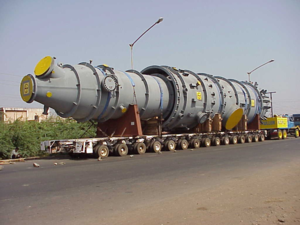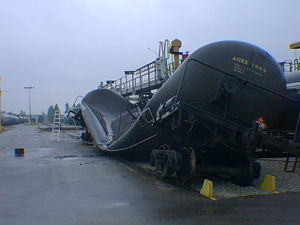Pressure Vessels: Difference between revisions
| Line 233: | Line 233: | ||
The endurance limit is the number of cycles for failure at a given set of conditions of cyclic stress. If this number of cycles is | The endurance limit is the number of cycles for failure at a given set of conditions of cyclic stress. If this number of cycles is | ||
exceeded, the vessel will fail (Towler | exceeded, the vessel will fail (Towler and Sinnott, 2013). | ||
=Conclusion= | =Conclusion= | ||
Revision as of 18:56, 26 February 2015
Title: Pressure Vessels
Author: David Chen
Steward: Fengqi You
Date Presented: January 13, 2014 /Date Revised: January 14, 2014
Introduction
Codes for pressure vessels can be found in the ASME Boiler and Pressure Vessel Code (ASME BPV code). While there is no formal definition, generally any closed vessel over 150 mm in diameter and that will experience a pressure difference of greater than 0.5 bar can be classified as pressure vessels. Types of equipment that can fit these descriptions include many reactors, separation columns, flash drums, heat exchangers, surge tanks, and storage vessels. Pressure vessels with a wall-thickness:diameter ratio of less than 1:10 can be classified as thin-walled, and the rest, thick-walled (Towler and Sinnott, 2013). Pressure vessels typically consist of a cylindrical shell and elliptical or hemispherical heads at the ends (Peters and Timmerhaus, 2003). Generally, chemical engineers will not be directly involved in detailed mechanical design of pressure vessels. This will be handled by mechanical engineers with experience in the field. However, chemical engineers will need to understand basic concepts of pressure vessel design in order to estimate costs and communicate specifications to those who will carry out the design. Most correlations for estimating cost depend heavily on the weight and type of material used. (Peters and Timmerhaus, 2003;Towler and Sinnott, 2013).
Basic data required by pressure vessel design engineer. It will be important for chemical engineer and vessel design engineer to communicate very closely (Towler and Sinnott, 2013):
1. Vessel function
2. Process materials and services (corrosion, deposits, etc.)
3. Operating conditions (temperature and pressure)
4. Materials of construction
5. Dimensions and orientation
6. Type of vessel heads to be used
7. Openings and connections required
8. Heating/cooling requirements
9. Agitation requirements
10. Specification of internal fittings
Designs and Codes
Many countries have codes and standards concerning pressure vessels. Compliance is usually legally required. The codes provide guidance on design, materials of construction, fabrication, inspection, and testing. In North America, the American Society of Mechanical Engineers Boiler and Pressure Vessel Code (ASME BPV Code) is used. There are twelve sections, and section VIII has three subdivisions. The section titles are listed below. Other sets of codes exist for storage tanks, fittings, and piping. It is important to always use the most recent revisions in design (Towler and Sinnott, 2013).
TABLE "American Society of Mechanical Engineers Boiler and Pressure Vessel Design Codes"
I Rules for construction of power boilers
II Materials
III Nuclear power plant components
IV Rules for construction of heating boilers
V Nondestructive examination
VI Recommended rules for the care and operation of heating boilers
VII Recommended guidelines for the care of power boilers
VIII Rules for the construction of pressure vessels
VIII. D1
VIII. D2 Alternative rules
VIII. D3 Alternative rules for the construction of high pressure vessels
IX Welding and brazing qualifications
X Fiber-reinforced plastic vessels
XI Rules for in service inspection of nuclear power plant components
XII Rules for construction and continued service of transport tanks
Design Temperature
Different temperature allowances are used above and below normal operating tempratures. For temperatures between -30 and 345 ⁰C, Turton gives a maximum allowance of 25 ⁰C above maximum operating temperature should be included. Above this, an even higher design allowance is used (Towler and Sinnott, 2013). Towler/UOP gives 50 ⁰F above the maximum operating temperature and -25 ⁰F below the minimum (Towler and Sinnott, 2013).
Maximum allowable stress is highly dependent on temperature, because metals weaken with increasing temperature. The vessel should not operate at higher temperature than the highest at which the maximum allowable stress was evaluated.
There is also a minimum temperature for which the vessel can be guaranteed to operate safely. Metals may become brittle at very low temperatures (Towler and Sinnott, 2013).The minimum design metla temperaure (MDMT) is the lowest temperature that can be expected in the vessel (Towler and Sinnott, 2013).
In specifying the maximum and minimum temperatures, disturbances caused by upstream processes and external factors need to be taken into account. These disturbances may include:transient conditions, upsets, auto-refrigeration, climate, other cooling factors (Towler and Sinnott, 2013).
Design Pressure
Vessels are often overdesigned relative to the maximum operating pressure. Turton suggests deisgn pressures of either 10% or 0.69-1/7 bar above the maximum operating pressure, whichever is greater. The maximum operating pressure is taken a 1.7 bar above normal operation. for example, the design pressure of a vessel that normall operates at 0-0.69 bar and 95-540 ⁰C is 2.76 barg (Turton et al., 2012). Towler suggests overdesign of vessel pressures by 5-10%.
For vessels that will experience external pressure, design pressure is based on the maximum difference between internal and external pressure.
Vessels that may potentially experience vacuum conditions must be designed to resist a negative pressure of one full atmosphere. Because of the large surface areas of some vessels, even a modest vacuum can lead to collapse. Circumstances that may lead to vacuum conditions include: startup/shutdown procedures, cooling vessels with condensable vapors, pumping or draining without proper venting, or some other unexpected disturbance (Towler and Sinnott, 2013).
Design Loads
Pressure vessels and the structures used to support them must be able to resist deformation and collapse when subjected to various loads, classified into major and subsidiary loads. Major loads must always be considered in the design of a pressure vessel, while subsidiary loads only need to be subjected to formal stress analysis when there is no other way to show that they can be supported. Subsidiary loads can often be evaluated by comparison with existing vessels.
Loads classified as major loads include design pressure, taking into account pressure heads; maximum operational weight, maximum weight under testing, wind, earthquake, and loads supported by the vessel.
Loads classified as subsidiary loads include: local stresses caused by supports, internal structures, and connecting pipes, shock loads caused by water hammer or surging, bending moments due to displacement of center of pressure, loads caused by differences in temperature and thermal expansion coefficients, and those caused by fluctuations of temperature and pressure.
The “worst case scenario” should be considered, and that the design should be based around that loading.
Maximum Allowable Stress
The maximum allowable stress is obtained by applying a safety factor to the maximum stress that the material can withstand under standard testing conditions. This allows for possible deviations from ideal material properties and ideal vessel construction.
The ASME BPV Code Section II Part D, Mandatory Appendix 1 details methods on obtaining maximum allowable stress. It is different depending on whether creep and stress rupture are dominant among the various stresses that are present.
Materials
Steel is the most common material used in construction of tanks and pressure vessels. Other construction materials include other alloys, wood, concrete, or fiber-reinforced plastics (some low-pressure applications).
Materials must be chosen that will be able to resist deformation and failure at the process temperature and pressure, and be compatible with the internal material. (Peters and Timmerhaus, 2003;Towler and Sinnott, 2013). Other factors for selection include ease of fabrication, availability of parts, and cost (Towler and Sinnott, 2013).
Wall Thickness
The required wall thickness of a vessel will depend on many factors, including: the strength of the metal at operating conditions (temperature and pressure), diameter of the tank, and the joint efficiencies. According to Peters, in "Plant Design and Economics for Chemical Engineers," minimum wall thickness, not including corrosion allowances, should not be less than 2.4mm for welded or brazed construction and 4.8mm for riveted construction. Thickness for unfired steam boilers should not be less than 6.35 mm. (Peters 552) Turton gives heuristics for wall thickness for rigidity based on vessel diameter: 4 mm (0.25 in) for 1.07 m (42 in) diameter and less than 8.1mm (0.32 in) for 1.07-1.52 m (42-60 in) diameter, and 11.7 mm (0.38 mm) for more than 1.52 m (60 in) diameter (Turton).
ASME BPV Code Section VIII D.1 states that wall thickness should always be at least 1/16 in, not considering corrosion allowance, material, or dimensions.
Minimum wall thicknesses do not include corrosion allowances. (11-13)
Corrosion Allowances
In general, corrosion allowances will range from 1.5-5mm. Corrosion allowances for heat transfer equipment are smaller, because wall thickness has an important effect on heat transfer (Towler and Sinnott, 2013).
Corrosion and erosion will lead to eventual thinning of walls, which compromises mechanical integrity. Corrosion allowance is constructing the vessels with thicker walls to allow for the thinning. the Peters, Timmerhaus, and West suggest 0.25 to 0.38mm annually or 3mm for 10 years.
Turton et al. suggest a corrosion allowance 8.9 mm (0.35 in) for known corrosive conditions, 3.8 mm (0.15 in) for noncorrosive streams, and 1.5 mm (0.6 in) for stream drums and air receivers.
In cases where corrosion is negligible over the lifetime of a vessel or does not occur, the vessel can be designed without the corrosion allowance (Towler and Sinnott, 2013).
Construction
Most pressure vessels are cylindrical (swaged vessels are an exception) and have integer length:diameter ratios (2:1, 3:1, 4:1). Vertical vessels are more commonly used than horizontal ones. This is because it is easier to have uniform distribution across the cross section, and they take up less space. However, there may be cases in which horizontal vessels may be preferable. They can be used to promote phase separation (in decanters, settling tanks, separators, and flash vessels), and to allow easy access to clean the inside (in heat exchangers).
Fabrication
In general, vessel shells are made by rolling and welding. It is easier for thin walls, however there may still be difficulty for small diameters. Vessels with thicker walls may need to be drum forged. The end closures are usually forged, and auxiliary components such as nozzles and support rings are welded on. Post weld heat treating (PWHT) is used to relieve residual stresses caused by forming and joining.
End Closures
The heads on the ends of the vessels can be hemispherical, ellipsoidal, or torispherical. Hemispherical heads have greater internal volumes than ellipsoidal heads, which have greater internal volumes than torispherical heads. The internal volumes are correlated with the cost of each type of head. Tangent and weld lines usually are not the same. Tangent lines are where the curvature ends. Weld lines are where the closures are attached. Different kinds of welds can be used. ASME BPV Code has guidelines concerning weld types and inspection.
Gasketed joints can be used then vessels need to be frequently opened, and for instrument connections. However, they are not used at high temperature or pressures because they may fail, and welds are stronger. They are also more prone to leaks than welded joints (Towler and Sinnott, 2013).
Supports
Different saddles will be used depending on a variety of factors. These factors include vessel dimensions and weight, temperature and pressure, arrangement, and fittings and attachments. Saddles are usually used for horizontal vessels. Skirt supports – vertical columns. Brackets – all types of vessels.
Welded Joints
The ASME BPV Code Section VIII D.1 defines four kinds of welds and criteria for their evaluation (Towler and Sinnott, 2013).
A. Longitudinal or spiral welds in the main shell, necks, or nozzles, or circumferential welds connecting hemispherical head sto the main shell, necks or nozzles
B. Circumferential welds int he main shell, necks, or nozzles or connecting a formed head other than hemispherical
C. Welds connecting flanges, tubesheets, or flat heads to the main shell, a formed head, neck or nozzle
D. Welds connecting communicating
High Pressure Vessels
High pressures are often required to carry out chemical processes. Section VIII Division 2 of the ASME BPV Code provides guidelines for pressure vessels that will experience pressures above 2000 psia. There are stricter restrictions and requirements regarding operating temperatures and stress analysis and testing. Divison 3 of Section 8 provides guidelines for pressures above 10,000 psia (680 bar).
At high pressures, compound vessels are often used instead of single-walled vessels, which may have difficulty providing the necessary strength (Towler and Sinnott, 2013).
Shrink-fitted cylinders
One way of creating compound vessels is to use multiple cylinders such that the outer diameter of the inner cylinder is larger than the inner diameter of the outer one. The outer cylinder can be expanded by heating, and compresses the inner cylinder when cooled. Multiple cylinders may be used.
Multilayer cylinders
Multilayer cylinders are made by wrapping thin plates around a tube in layers. They are heated, tightened, and welded.
Wound vessels
Wound vessels are cylindrical vessels reinforced by winding on wire or thin ribbons under tension. The strips can be interlocked to provide more strength for high-pressure applications.
Autofrettage
The internal surface of the vessel is subject to enormous pressures to prestress it. When released, the inside will be under compression by the outside. The vessel can be used up to the “autofrettage” pressure without further deformation.
Liquid Storage Tanks
Vertical cylindrical tanks are common in industry for storage of liquid. Volumes can range from a few hundred to several thousand gallons. The main load for these tanks is the hydrostatic head. However, tanks with large vertical profiles may need to account for wind loading, and perhaps snow on the top as well.
Testing
Nondestructive testing
Nondestructive testing methods are ways of evaluating the integrity of a vessel without compromising it. Inspections need to be carried out for new vessels and regularly once operation begins.
The simplest is a visual inspection for cracks or defects on the surface. It is also the cheapest, requiring only an inspector.
Radiography is used to detect subsurface cracks and defects. It is difficult and expensive, and may require specialized inspectors. It is required by the code in certain cases.
Ultrasonic detection can be used during operation to detect wall thinning.
Pressure Testing
The ASME BPV Code requires pressure testing with an inspector present before vessels can be approved.
Both hydraulic and pneumatic pressure tests are used. Hydraulic testing is preferred to pneumatic for safety reasons because much less energy is stored in compressed liquid than in compressed gas (Towler and Sinnott, 2013).
The equation below is typically used to determine an appropriate test pressure (Towler and Sinnott, 2013).
Where:
= design pressure, N/mm^2
= maximum allowable stress at test temperature, N/mm^2
=maximum allowable stress at the design temperature, N/mm^2
= corrosion allowance, mm
= actual plate thickness, mm
Adjustments are made for the testing and design temperature. If the thickness cannot be calculated using known methods, a hydraulic proof test is required by the ASME BPV Code (Towler and Sinnott, 2013).
Fatigue-induced failure
Stress cycles can occur as a result of normal operations. Possible periodic causes include:
1. Fluctuations in pressure
2. Temperature cycling
3. Vibrations
4. Water hammer
5. Fluctuations in flow of fluids or solids
6. Fluctuations in external load
The endurance limit is the number of cycles for failure at a given set of conditions of cyclic stress. If this number of cycles is exceeded, the vessel will fail (Towler and Sinnott, 2013).
Conclusion
Many processes in the chemical industry are carried out at pressures greater than the atmosphere. Gases are also compressed and stored. Any vessel that will experience a pressure difference between the sides of the walls must be strong enough to withstand it. Usually the difference is between the inside and the external atmosphere, but it can also exist internally, as in a heat exchanger. A large amount of potential energy can exist as a pressure difference, and correct design of pressure vessels is an integral part to plant safety. As such, there are codes and standards guiding all aspects of using them. In North America, the American Society of Mechanical Engineers Boiler and Pressure Vessel Code (ASME BPV Code) is used. While chemical engineers will generally not carry out the immediate design, they will need to communicate specifications based on their understanding of process conditions to the vessel design engineers.
References
- Towler, G.P. and Sinnot, R. (2012). Chemical Engineering Design: Principles, Practice and Economics of Plant and Process Design. Elsevier.
- Peters, M.S. and Timmerhaus, K.D. (2003). Plant Design and Economics for Chemical Engineers, 5th Edition. New York: McGraw-Hill.
- Turton R.; Bailie, R.C.; Whiting, W.B.; Shaeiwitz J.A.; Bhattacharyya D. (2012). Analysis, Synthesis, and Design of Chemical Processes. Upper Saddle River: Prentice Hall.





![{\displaystyle TestPressure=1.30\left[P_{d}{\frac {S_{a}}{S_{n}}}\times {\frac {t}{t-c}}\right]}](https://wikimedia.org/api/rest_v1/media/math/render/svg/65755f6f19fae66edc391a2aa97dbe6aa41ff3c5)




